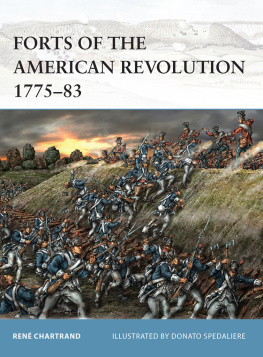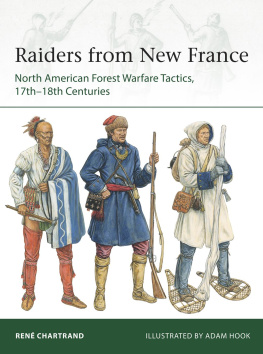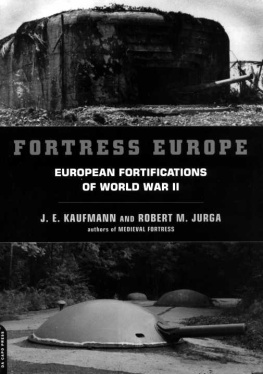Author
Ren Chartrand was born in Montreal and educated in Canada, the United States, and the Bahamas. A senior curator with Canadas National Historic Sites for nearly three decades, he is now a freelance writer and historical consultant. He has written numerous articles and books including over 40 Osprey titles. He lives in Gatineau, Quebec, with his wife.
Illustrator
Donato Spedaliere was born in Lausanne, Switzerland, and moved to Tuscany, Italy, at the age of ten, where he still lives today. He has studied in Florence, and served in the Italian Army as a paratrooper. Since 1995, he has worked as a professional freelance illustrator for publishers in Italy and abroad. His artworks are to be found in many books, encyclopedias, magazines, and museum collections. Recently he has worked on two movies, providing concept designs and matte paintings, as well as acting as the supervisor of the special effects team for the film Obulus.
ARTISTS NOTE
Readers may care to note that the original paintings from which the color plates in this book were prepared are available for private sale. The Publishers retain all reproduction copyright whatsoever. The artist can be contacted via the following email address: The Publishers regret that they can enter into no correspondence upon this matter.
AUTHORS NOTE
It can be said that the subject of this study is very fleeting because the fortifications were, except for Quebec City, nearly all temporary earth and wooden structures that were often quickly put together to meet an immediate purpose. They were numerous, came in all sizes and shapes, and appeared and disappeared all over eastern North America according to the movements of armies. As a result of this fluidity as well as the necessarily modest size of this book, a narrative of the main operations as well as some, but not all, secondary engagements involving the use of fortifications was chosen as the best way to obtain an overall view. What emerges is the remarkably important influence the use of fortifications did have in the struggle and winning of American independence, typified by the 1781 sieges of Pensacola and Yorktown that basically ended active operations in North America. A few notes on the corps of engineers involved and a glossary round out this study. The author wishes to thank and laud editors Marcus Cowper and Nikolai Bogdanovic and the illustrators for their great work and patience in dealing with the rather complicated aspects of this very diverse and fascinating subject. He also particularly thanks the Library of Congress, the Boston Public Library, the Yale University Art Gallery, and the Anne S. K. Brown Collection at the Brown University Library for their remarkable online access in high resolution to superlative maps and plans, the few reproduced in this study being a minute fraction of the impressive collections presented in the true and free spirit of the dissemination of knowledge to all.
THE WOODLAND TRUST
Osprey Publishing are supporting the Woodland Trust, the UKs leading woodland conservation charity, by funding the dedication of trees.



First published in Great Britain in 2016 by Osprey Publishing,
PO Box 883, Oxford, OX1 9PL, UK
1385 Broadway, 5th Floor, New York, NY 10018, USA
E-mail:
Bloomsbury is a trademark of Bloomsbury Publishing Plc
This electronic edition published in 2016 by Bloomsbury Publishing Plc
2016 Osprey Publishing Ltd
OSPREY PUBLISHING IS PART OF BLOOMSBURY PUBLISHING LTD.
All rights reserved
You may not copy, distribute, transmit, reproduce or otherwise make available this publication (or any part of it) in any form, or by any means (including without limitation electronic, digital, optical, mechanical, photocopying, printing, recording or otherwise), without the prior written permission of the publisher. Any person who does any unauthorised act in relation to this publication may be liable to criminal prosecution and civil claims for damages.
A CIP catalog record for this book is available from the British Library.
ISBN: 978-1-4728-1445-6
PDF e-book ISBN: 978-1-4728-1446-3
e-Pub ISBN: 978-1-4728-1447-0
Editorial by Ilios Publishing Ltd, Oxford, UK (www.iliospublishing.com)
Maps by Bounford.com
Artwork illustrations by Donato Spedaliere
INTRODUCTION
Although the American War of Independence was largely fought in the field, it could also be said that many of the key battles of the conflict were sieges against fortified positions. Some of these engagements were large-scale affairs, worthy of any siege in Europe; indeed, Yorktown, the most important siege in the American theater of operations, had such an impact that the towns surrender led to Great Britain losing the war. However, there were hardly any fortified cities or large stone citadels in North America. Most cities only had a few batteries and no effective curtain walls to enclose them.
The military engineers of four nations were active in the 177583 North American campaigns. All sides resorted to constructing a wide variety of earthen and wooden field fortifications according to the various European military engineering manuals, all of them inspired by the principles of French Marshal Sbastien Le Prestre de Vauban (16331707), arguably one of historys greatest military engineers.
Key fortifications from the American Revolutionary War
At the outset of the war, the British Armys Corps of Engineers was responsible for protecting Great Britains possessions in North America, but initially very few commissioned professional engineers were present. In 1775, out of 61 engineer officers in the corps, there was only one in Quebec, one in Montreal, one in Halifax, one in Boston, one in New York, and one at Pensacola. During the conflict, the number of officers, who served with competence and distinction in North America, rose to 38, although they were too few: the whole corps only numbered 75 engineers in 1780. Aspiring British engineers usually attended the Royal Military Academy at Woolwich, which mostly educated artillery officers, both services being under the Board of Ordnance and not the Army at large in the peculiar organization of Britains armed forces. Engineers were thus more seen as uniformed technicians rather than fighting officers. It might be added that, due to social class perceptions, they had less influence as general staff officers than engineers in the French, American, or Spanish armies. Be that as it may, those posted to North America during the conflict were overwhelmed with work. For instance, John Montresor was the only engineer officer with General Thomas Gages army in Boston for most of 1775, a situation often repeated on many occasions during the war.
The Americans did not have a professional establishment of military engineers at the outset of the conflict, although the absolute necessity of having such professionals in their nascent army was recognized. A few Americans had gleaned some engineering knowledge from books and Richard Gridley, William Burbeck, Jeduthan Baldwin, and Rufus Putnam became occasional or permanent engineers serving with General George Washington, but none had been trained at a military academy and all lacked the advanced, specialist skills required of army engineers. European volunteers that had such training were sought and commissioned as engineers in the Continental Army. Some of the early engineer volunteers presenting themselves in 1776 proved to be frauds, while others, notably Polish-born Tadeusz Kosciuszko, would become amongst the most trusted members of the American Corps of Engineers. Nearly all came from France, some loaned by the French Armys engineer corps (Corps Royal du Gnie) in 1777. One of these was the outstanding Louis Duportail whose obvious expertise, cooperative attitude, and shrewdness led the Americans to appoint him the senior engineer officer with the rank of brigadier-general in November 1777; he is also remembered as the father of American engineering. A professional American Army engineering branch thus took form. Its initial members were mostly French-trained officers who could contribute the necessary expertise to American armies in the field. While at Valley Forge, Duportail created a modest engineering school later moved to West Point. From 1779, there were three engineer companies of sappers and miners to better supervise the construction of field fortifications. By the later stages of the war, the Americans had developed a military engineering capacity such as never seen before in the country.
Next page
















